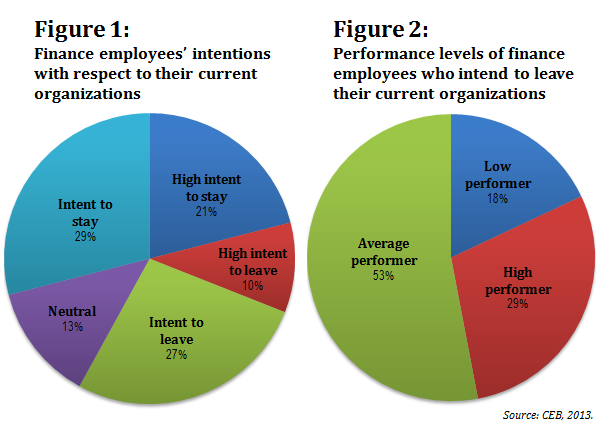 Halfof all finance employees lack commitment to their current jobs, andthe ones who are most likely to leave are the ones already meetingor exceeding expectations, including nearly one in three rated ashigh performers. At the same time, the vast majority of CFOs whomCEB surveyed as part of our Finance Talent research are already unhappywith the mix of finance talent at their disposal. They need tostart doing a lot more to retain their best employees.
Halfof all finance employees lack commitment to their current jobs, andthe ones who are most likely to leave are the ones already meetingor exceeding expectations, including nearly one in three rated ashigh performers. At the same time, the vast majority of CFOs whomCEB surveyed as part of our Finance Talent research are already unhappywith the mix of finance talent at their disposal. They need tostart doing a lot more to retain their best employees.
These are among the key take-aways from a recent CEB survey ofnearly 700 finance managers at more than 75 companies around theworld. We found dissatisfaction at both the employee and theexecutive level. More than one-third of finance employees said theyare actively planning to leave their current jobs within a year.And more than two-thirds of those employees are either meeting orexceeding expectations, so the turnover will likely createheadaches for their CFOs. (See Figures 1 and 2, below.)
|The challenges will extend beyond short-term disruptions inworkflow. High-performing employees typically have valuableinstitutional knowledge and maintain strong professionalconnections. They are often critical to revenue generation orproduct development, as well, so replacing them may be difficult.Plus, turnover among finance's high performers can present aserious risk to succession planning. As the CFO is increasinglyviewed as a CEO in waiting, so finance staff is becoming animportant component of companies' talent pipeline.
|The typical approach to improving retention is to focus oncompensation, but CEB's research indicates that this approach isincomplete. Although compensation-driven strategies attract talent,they are not the driving factor in retaining top performers.Instead, successful retention programs usually entail training anddevelopment activities, such as highly personalized coaching andwell-thought-out staff rotations. In addition to boostingretention, these programs drive competency development,particularly in the “soft skills,” which our research identified ascrucial differentiators for the best finance departments.
|Not only does low investment in retention lead to increasedturnover, but it bleeds into a myriad of other issues that canthreaten the entire business: poor/deteriorating staffcompetencies, lack of a leadership pipeline, and low productivitylevels. To retain the best and brightest on their finance teams,companies need to pursue best-practice approaches to finding,hiring, developing, and retaining key individuals.
|
To delineate these best practices, CEB reviewed financeemployees' responses to our quarterly Global Labor Market Survey ofmore than 18,000 employees in 28 countries. We compared employeeengagement, satisfaction, and job-seeking behaviors with factorssuch as compensation and career opportunities. The data revealedthat finance employees' levels of engagement and satisfactiondepend not just on compensation and benefits, but also on the levelof impact of the job, the opportunity for skill development, andoptions for work-life balance.
|We consistently found that best-in-class finance departmentsbuild their retention strategies around nonmonetary rewards, suchas leadership opportunities and compelling career paths. They alsoshare a commitment to investing in thoughtful, long-termdevelopment of their high-performing employees. The good news isthat we were able to identify a series of transferable ideas,beyond competitive compensation, that progressive companies arealready using to build a healthy talent pipeline.
||
|
|
1. Understand Your RetentionRisk
In order to better retain key employees, senior executives needto clearly understand the factors that drive retention risk forthese people. These factors vary not only from company to company,but from role to role and from employee to employee. CEB hasidentified two sets of risk criteria that organizations need toevaluate: position risk and individualrisk.
|We define position risk as the level of risk that anorganization would be exposed to were it to lose any employee in agiven position, regardless of that employee's performance. A jobhas an elevated position risk if it is:
- crucial to maintaining external relationships andpartnerships,
- crucial to product development,
- crucial to revenue generation,
- crucial to strategy development and execution,
- difficult to quickly replace through external hiring,
- difficult to identify an internal successor, and/or
- senior within the organization.
Any one of the above factors means a position has elevatedposition risk. Two or more flag a position as meriting especiallyclose consideration. Some of these factors have more impact withincertain types of businesses, so leaders must use their judgmentwhen assessing positions' risk within their own organization.Nevertheless, a company's executives should be able to reachconsensus on which positions require the most attention inretention efforts.
|Determining individual risks can be more subjective if a companydoesn't have the right processes in place. We define individualrisk as the level of risk that an organization would beexposed to if it lost a specific, named employee who holds a keyposition. This type of risk divides along two broad subsets of riskfactors: How well the employee is performing and whether theemployee is happy. To identify which individuals are highperformers, a CFO should answer several questions:
- Has the employee been designated formally as a high performer(HIPO) or a potential HIPO?
- Is the individual a named successor to any of the company'sexecutive-level roles?
- Is the individual a critical conduit for information within theorganization?
- Does the individual possess a high degree of valuableinstitutional knowledge or functional expertise?
If the answer to any of the above questions is yes, the CFOshould immediately evaluate how satisfied the employee is withinthe organization, and how likely he/she is to remain that way. Thisevaluation may be as simple as considering the length of theemployee's daily commute, or it may be a complex analysis of thepossible directions the employee's career path might take withinthe company. Questions to ponder include:
- Is the employee's total compensation package equitable in thecurrent market?
- What kind of development opportunities are available tohim/her?
- Has the employee recently been dissatisfied with a promotion ora performance review?
- How good is the employee's relationship with his/her directmanager?
- Has the employee's performance been improving ordeclining?
- Are we aware of any personal factors (such as commute) that mayinfluence whether the employee decides to stay or leave?
CFOs must be ready to act when they identify a key employee withelevated levels of both position risk and individual risk. Anormally functioning business will have only a handful of these“double-risk employees.” According to our research, companies needto make aggressive plans for retention when an individualsimultaneously faces just one factor in each set.
||
2. Invest to Get Employees Invested
Many CFOs who believe that soft skills are important fail toinvest substantially in improving these skills for their staff.CEB's research indicates that even among finance teams that seethemselves as business partners, fewer than half invest in programsdesigned to build employees' business acumen, such as structuredcoaching or rotation programs.
|To understand the importance of soft skill development, CEBresearched the impact of more than 100 finance staff competencieson the effectiveness of the overall finance department. We groupedthese skills into five categories: builder competencies, persuadercompetencies, strategist competencies, learner competencies, anddoer competencies. The last two categories—learner and doercompetencies, marked by strong functional execution—turned out tohave surprisingly little effect on the finance function'seffectiveness. Instead, the builder, persuader, and strategistcompetencies—all marked by the presence of soft skills, such ascommunication skills and team building—served as the clearestdrivers of departmental effectiveness.
|This “pathfinder” skill set, representing the nontechnicalcompetencies of the finance function, is what finance leaders needto be most conscious of as they develop the talent mix on theirteams. We found that the best companies not only implement softskills development programs, but ensure that these programs rapidlyincrease learning among high-performing employees and bring themcloser to the business.
| One well-known technology companydevelops finance employees' business acumen and other soft skillsthrough a structured, three-year rotation program. Participants areall entry-level finance staff, who move rapidly through differentfunctions and business units in order to develop into well-roundedfinance employees. Senior executives coach participants on at leasta quarterly basis. At the end of their three years in the program,participants are placed in the organization based on businessneeds, input from coaches, and the participants' areas of interest.The innovative program provides the company with a pipeline oftalented staff who can effectively deal with a changing and complexbusiness environment. It also helps the company increase retentionrates while evaluating high performers' potential as future financeleaders.
One well-known technology companydevelops finance employees' business acumen and other soft skillsthrough a structured, three-year rotation program. Participants areall entry-level finance staff, who move rapidly through differentfunctions and business units in order to develop into well-roundedfinance employees. Senior executives coach participants on at leasta quarterly basis. At the end of their three years in the program,participants are placed in the organization based on businessneeds, input from coaches, and the participants' areas of interest.The innovative program provides the company with a pipeline oftalented staff who can effectively deal with a changing and complexbusiness environment. It also helps the company increase retentionrates while evaluating high performers' potential as future financeleaders.
There is no question that such a program requires substantialinvestment of time, personnel, and capital. The size of thatinvestment depends on several factors, including the number ofparticipants, the organizational structure, and the type ofrotation exposure. A finance function looking to implement arotation program may consider four types of rotations:intra-departmental movement, transfers between finance and thebusiness units, moves between regional finance teams and thecorporate finance function, and geographic rotations. Large-scaleand international rotations are the most costly, and they may beout of reach for some companies. It is important for executives tothink carefully about what type of rotation, if any, would bestimprove competency and career satisfaction within theirorganization.
|For the technology company, the rotation program's return oninvestment has been evident. The program simultaneously buildsparticipants' internal networks and competencies that help themunderstand the business. Graduates of the program are twice aslikely to be rated high performers as is the average new hire, sothe program is helping build a deep bench of future financeleaders.
||
3. Match Potential Leaders to Highly DemandingRoles
Since 2009, leadership investment for the middle managementlayer has declined by 20 percent, which has led to a lack offinance managers who are prepared to take on new responsibilitiesand develop junior staff. The most successful companies rigorouslymanage the learning and performance of top finance staff.
|\For example, one multinational uses the concept of “crucibleroles,” which it defines as complex, highly demanding roles thathave a high business impact. The company reserves these positionsfor individuals it has identified as up-and-coming leaders in orderto engage and retain them. Make no mistake: These are not“laboratory” assignments; they are key marketing andbrand-management positions associated with crucial brands orgeographic markets within the company's portfolio. In fact, becausethe crucible roles are so critical to the business, the company hasdeveloped a highly structured support system for these highperformers. Senior leaders take responsibility for introducing themto key colleagues across the business, while managers monitor theirengagement via regular, informal check-ins.
|With this support structure in place, individuals in crucibleroles are held to a higher standard. They are expected toconsistently outperform their peers by a significant margin, whilerapidly acquiring new skills. After a period of three years,typically, a high performer who has extracted the full learningvalue from a crucible role is rotated to a very different positionto continue leadership development. Employees who underperform inthe program are moved to non-crucible roles that better suit theirabilities.
|Throughout the process, managers work hard to matchhigh-potential employees with crucible roles that suit their careergoals. Not surprisingly, this program has resulted in a notableimprovement in the engagement, productivity, and retention ofcritical finance talent within this company.
|Other organizations can take a similar approach bysystematically assessing positions for their business impact andcomplexity, then matching high-performing employees to those roles.Two questions can provide a litmus test to identify roles with bothcomplexity and high impact:
- If the person in this role is unsuccessful, is theresignificant risk to the business?
- Does the person in this role need to master a broad range ofskills?
If the answers to both questions are “yes,” the position islikely a crucible role.
||
A Retention Program that Works for YourBusiness
It's clear from our research that the past several years havebeen trying for both CFOs and their employees. It's also clear thatthe best companies are taking action to redress thisdissatisfaction, and they're starting with their most valuableemployees.
|There are many ways to raise engagement and satisfaction levelsamong high-performing and high-potential staff. Launching a globalrotation program or a structured “crucible role” system may not befeasible for your company. The most effective businesses createappropriate programs that work well within their corporate culture.Most utilize the network of senior leaders that the organizationalready has in place. Many also encourage collaboration across thebusiness, whether formally or informally.
|Retaining high-performing employees is an investment in theorganization's future leadership, and successful companies buildbridges to help today's high performers reach tomorrow's boardroom.As the economy enters a new phase, finance departments that succeedin retaining high performers will be able to turn their attentionto transformative business goals. Those that don't may see analready-frustrating talent situation get a lot worse.
|See the sidebar:
—————————————–
| Kruti Bharuchais senior director at CEB. She leads CEB's research on The NewFinance Skill Set—Hiring, Developing and Managing the FinanceCompetencies that Matter Most.
Kruti Bharuchais senior director at CEB. She leads CEB's research on The NewFinance Skill Set—Hiring, Developing and Managing the FinanceCompetencies that Matter Most.
Complete your profile to continue reading and get FREE access to Treasury & Risk, part of your ALM digital membership.
Your access to unlimited Treasury & Risk content isn’t changing.
Once you are an ALM digital member, you’ll receive:
- Critical Treasury & Risk information including in-depth analysis of treasury and finance best practices, case studies with corporate innovators, informative newsletters, educational webcasts and videos, and resources from industry leaders.
- Exclusive discounts on ALM and Treasury & Risk events.
- Access to other award-winning ALM websites including PropertyCasualty360.com and Law.com.
*May exclude premium content
Already have an account? Sign In
© 2024 ALM Global, LLC, All Rights Reserved. Request academic re-use from www.copyright.com. All other uses, submit a request to [email protected]. For more information visit Asset & Logo Licensing.







